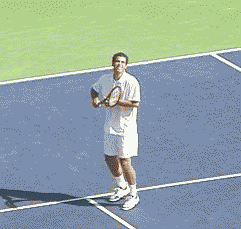|
TennisOne QuickTips
QuickTip: Make Your Overhead a Weapon Dave Smith Here, are a couple of quintessential tips that can help transform your overhead from a liability into a lethal weapon!
Often, we see players prepare for their overhead as if they are learning to serve for the first time; namely, racquet head back behind their back as if they were scratching their back. While this isn't a terrible way to approach learning the serve or the overhead, players who first learn this pattern must eventually move on to a more refined stroke pattern. The first move involves not taking the racquet back, but taking the hitting arm's elbow back. In fact, as the body turns sideways in preparation, the racquet head should stay in front of the hitting arm with the tip of the racquet pointing towards the oncoming lob. Whip a “High Five” The overhead should be thought of as a ‘cracking a whip.' Think of the proverbial lion tamer. From the preparation of the racquet tip held in front, the swing becomes a whip like move without stopping the racquet on the backswing. If we are using the more desirable continental grip, the analogy of giving the ball a ‘high five' creates the correct visual conception of the swing. The racquet moves from an edge-on position with the pronation of the forearm bringing the strings flush to the ball as if giving the ball a high five with the palm.
The elbow moves forward, only to initiate the swing. Skilled overheads feature the elbow stopping its forward progress allowing the whip of the racquet head over the arm. This action maximizes racquet head speed. Finish Beginners notoriously lead with the elbow through contact and end up pulling the elbow down, leaving the racquet head well behind the hitting arm even after contact. This action results in a much slower racquet head speed and also limits the variability and direction of the overhead. Instead of leading with the elbow, skilled players leave their elbow up allowing the racquet head to finish below the hitting forearm before the arm relaxes and finishes down at the player's side. Practice this technique until it becomes fluid and comfortable. Then work on the timing of hitting the lob out of the air. You will soon find yourself with a formidable overhead that can be hit from anywhere on the court! (Click link to purchase Dave Smith's book, Tennis Mastery, at tenniswarehouse.com |

